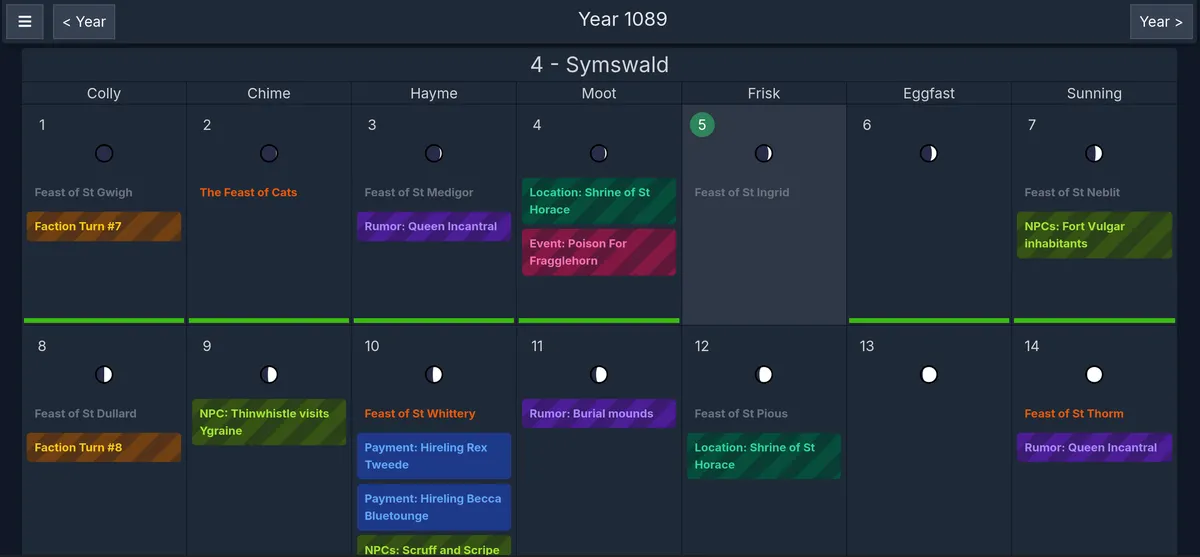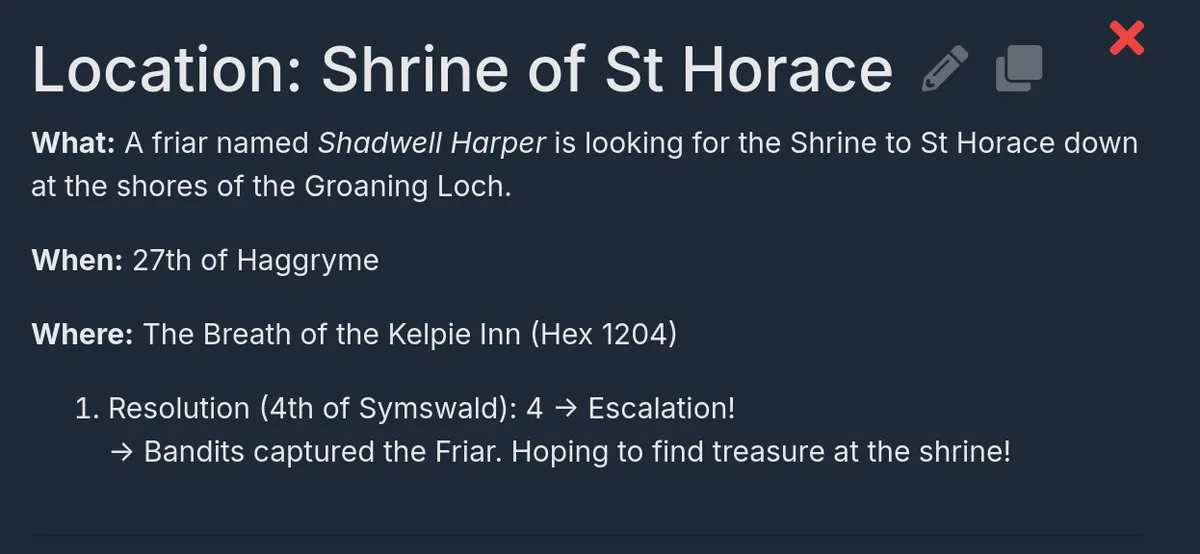Calendar Chronicles

Have you ever run a campaign where past events slipped through the cracks? Time marches on in the real world—shouldn't it do the same in your game? Because TTRPGs allow for plenty of improvisation, I usually recall enough from previous sessions without taking extensive notes. However, when I began running a long campaign spanning more than 10 sessions, I realized I'd forget important details without solid note-taking. Tracking factions systematically helped a lot, and I also encourage players to take notes in a shared space. But today, I want to highlight a tool that's often overlooked.
Use a Calendar
One approach that transformed how I run long campaigns is using a calendar. It visualizes the passage of time and brings structure to your world, making abstract fantasy dates and timelines more tangible.
Any calendar can work—whether it's printed, stored as a text file, or managed through an app. For my Dolmenwood campaign, I use Fantasy Calendar because someone on the Necrotic Gnome Discord preloaded it with seasons, holidays, and moon cycles. It also lets me define event categories, some of which remain private. I can share the calendar with players while keeping certain details hidden. If you don't need a player-facing one, Calendarium is a plugin for Obsidian that uses Fantasy Calendar's data models and integrates the calendar right into your workspace.
With a scheduling tool set up, I track important actions or events, such as:
- Long-term effects (injuries, curses, etc.) and their resolution.
- Payment due dates, such as taxes, hireling salaries, or debts.
- Meetings and deadlines for NPCs, quests, and factions.
Assigning dates ensures I stay on top of the game's evolving elements.
More Than a Time Tracker
I now use the calendar for more than just counting days. Imagine players hear a rumor about treasure in a nearby dungeon but decide to finish another quest first. I set a "timer" for that rumor in case they check on it later. The length depends on the narrative and circumstances—days, weeks, or months—often determined by a dice roll.
How It Works
- Set a timeline for the event (e.g. days, weeks, months, etc).
- Add the event to the calendar with a reminder.
- When the date arrives, roll to see what happened (I use 2d6, similar to a reaction roll):
- Rolling High: Someone else resolved it. Another party might have looted the dungeon first.
- Rolling Average: Nothing's changed. Create a new timer.
- Rolling Low: The situation escalated (stronger foes moved in, or a faction got involved).
- Update the calendar with new outcomes, deadlines, or consequences.
For example, if I roll two weeks for that dungeon rumor, I mark that date to revisit it. Maybe another party cleared the dungeon first, leaving only scraps. Or perhaps the Church got involved, believing a sacred relic was inside—thus escalating the situation. Either way, new storylines emerge.
Share these outcomes with your players. If another adventuring party scooped the treasure, let your players hear about it at the local tavern. Give that rival party a name and a bit of personality, and watch your players squirm at the thought of someone beating them to the loot.

Expand the Calendar Role Further
Beyond in-session details, the calendar can anchor your entire campaign prep. I schedule events for anything happening off-screen. Some examples include:
- Cleared dungeons: Schedule a date to restock them.
- Frequent random encounters: Set times to refresh encounter tables.
- Important NPC activities: Track major progress and outcomes.
- World events: Decide when news of player or faction actions spreads to other regions.
This might sound like a lot, but it's usually straightforward. Sometimes multiple events converge on the same day—that's part of the fun. Keep resolutions quick and simple—use random or spark tables to fill in details only when needed.
This approach keeps my long-running campaigns organized and dynamic. A calendar makes it easy to add entries during or after sessions, ensuring the game feels like a living world. By simulating events outside of player involvement, the world evolves naturally. These changes ripple outward, creating new connections, opportunities, and challenges for the players to discover.

Get the Players Involved
Encourage players to manage their own deadlines, such as quest due dates or upcoming meetings with that enigmatic wizard who only speaks in riddles. Giving them responsibility reinforces their agency. If you have a shared, player-facing calendar, they can log reminders for:
- Paying retainers or debts: Let them track their financial obligations.
- Scheduling NPC interactions: Faction meets, promised rendezvous, etc.
- Notable world events: Annual tournaments, festivals, or important holidays.
This is where a player-facing calendar shines, as it keeps all shared dates organized in one place, reducing confusion and streamlining gameplay. Having two versions (one private, one public) is also perfectly reasonable. Offload some of the note-taking to your players—it's in their best interest to do so unless they enjoy forgetting key details. Giving them more responsibilities, similar to mapping, also increases engagement. These small tasks make the game feel more tangible than just conversation. Rolling dice is popular for the same reason!
Common Pitfalls
While using a calendar is incredibly helpful, watch out for:
- Overloading the Calendar: You don't need to track every minor NPC or random encounter. Focus on the important stuff.
- Forgetting to Check It: Make it a habit to review the calendar before, during, or after sessions.
- Overcomplicating Outcomes: Keep resolutions simple and expand them only if they become relevant.
- Player Disconnection: Ensure players are aware of key dates or events so it isn't just a solo exercise.
Conclusion
Once I started using a calendar regularly, it became essential to my prep. It fosters immersion, consistency, and a sense of a living world. When players revisit old locations, they'll find changes—sometimes for the better, sometimes for the worse, but always with new opportunities waiting. By adding a simple scheduling tool to your toolkit, you'll create richer storytelling, more dynamic choices, and a truly evolving world for your players to explore.
Further Reading
For more inspirations on calendar and events:
- A Simple Calendar for Timekeeping - Traverse Fantasy
- About Damn Times: A Campaign Event Table - Silver Arm Press
- Calendars, Not Just Maps - Prismatic Wasteland
- Tempus, Fudge It - Prismatic Wasteland
- Strict time records - Vladar's Blog
- Adventure Forecasts - Permanant Cranial Damage
- A Middle-earth Calendar - Rise Up Comus